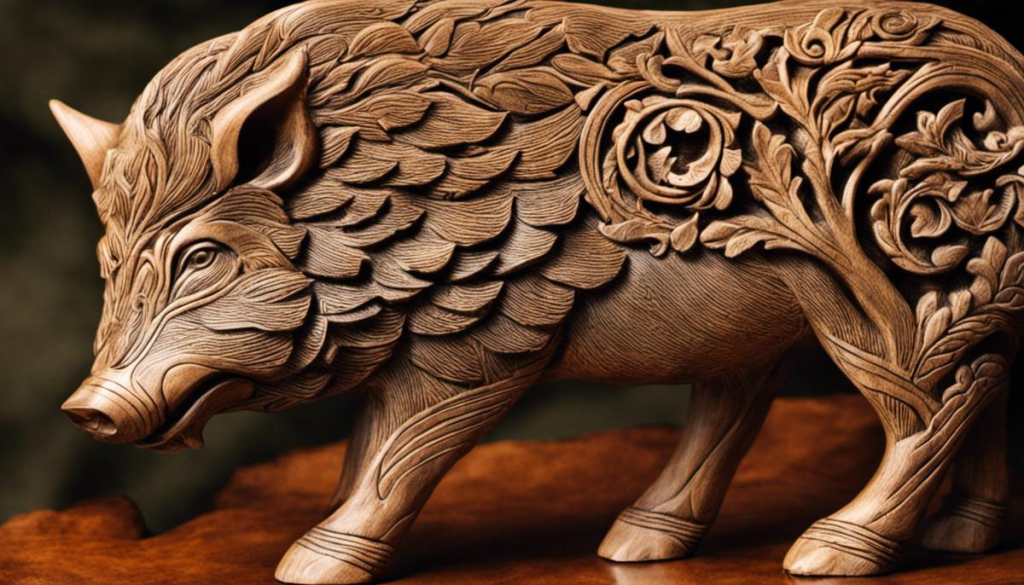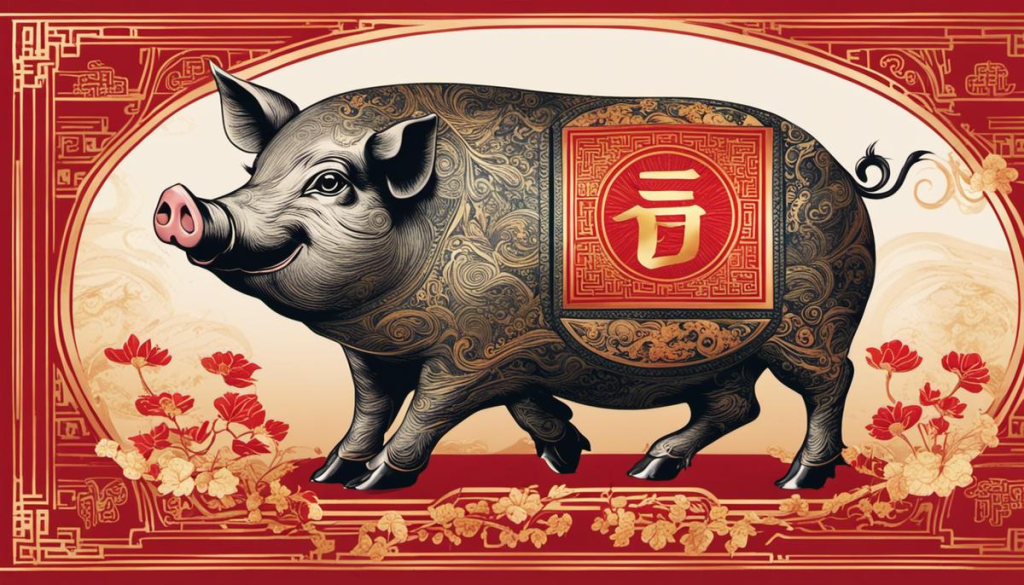In the expansive tapestry of global folklore, few animals hold as prominent or diverse a place as swine. Spanning continents and cultures, pigs are woven into stories and mythologies, often symbolizing a range of contrasting attributes – from gluttony to prosperity, from obscenity to sanctity. The symbolism is as diverse as the cultures from which these tales emanated, and this dive into swine in global folklore presents an opportunity to explore an intriguing variety of perspectives. Specifically, we shall travel through European, Asian, African, and Native American folklore, offering a multidimensional look at the cultural, historical, and geographical contexts that birthed these narratives.

Symbolism of Swine in Folklore
Symbolism of Swine in Folklore
Pigs or swine hold varying significance in global folklore and traditions, often symbolizing fertility, prosperity, and gluttony. In some cultures, they are seen as symbols of wealth and abundance, whereas others view them as emblems of greed and indulgence. The symbolic importance of swine in folklore is deeply rooted in a given culture’s history, traditions, values, and collective consciousness.
European Folklore
In European folklore, for instance, pigs often symbolize good fortune and prosperity. In Germany, pigs, known as “Glücksschwein” or “lucky pig”, are traditionally given as New Year gifts to bring good luck in the coming year. Furthermore, in Celtic mythology, the pig represents fertility and was associated with the mother goddess Cerridwen, who assumed the form of a large sow.
Chinese Zodiac and Mythology
Pigs also figure prominently in Chinese zodiac and mythology. A significant symbol of wealth and fortune, the pig is one of the twelve Chinese zodiac animals and represents luck, good fortune, and fertility in China. It is believed that people born in the year of the pig are destined for prosperity and wealth.
Native American and Pacific Islander Traditions
In Native American mythology, the pig does not feature as prominently, given the limited presence of swine in North America prior to European colonization. However, in the traditions of some Pacific Islander cultures, the pig is revered and often associated with status, wealth, and power, frequently appearing in tales and myths.
African and Middle Eastern Symbolism
In African folklore, the pig, particularly the wild boar, has been symbolic of courage and fearlessness, often portrayed as a formidable adversary in many tales and legends. Further east, in Islamic and Jewish traditions, the swine has been viewed differently due to religious dietary laws, which deem it unclean.
Negative Symbolism
In addition to these positive representations, pigs also carry a less flattering symbolism in some cultures. Given their habit of wallowing in mud and their perceived unselective eating habits, pigs have sometimes been associated with aspects of gluttony, laziness, and lack of cleanliness.
Ritualistic Significance
One common thread that can be observed across multiple cultures is the extensive use of pigs in ritualistic contexts, suggesting a broader significance beyond the immediate association with food supply. For instance, pig offerings were common in ancient cultures such as the Roman Empire and the Chinese Shang Dynasty.
Conclusion
In summary, the pig is an animal imbued with rich, complex symbolism in global folklore. Across various cultures, the pig is used to symbolize a diverse range of concepts from abundance and good fortune to indulgence and uncleanliness. This diverse symbolism underscores how the interpretation of animals is inherently shaped by the cultural contexts they are found in.

Photo by sonika_agarwal on Unsplash
Swine in European Folklore
The Celtic Boar in European Folklore
The boar symbol in Celtic folklore on the other hand, is indicative of the warrior spirit, bravery, and combat. The boar’s confrontational and unrelenting fighting style, admired by the Celts, is reflected in their cultural narratives and symbology. Indeed, the boar’s image often features prominently in Celtic artistic representations, such as the notable Boar Stone, a Pictish stone with a detailed carving of a boar.
Notably, Celtic heroes and deities are frequently linked with boars. In Welsh tales, a well-known story of King Arthur involves him and his men engaged in the pursuit of a supernatural boar across the terrain. Similarly, in Irish mythology, the god Arawn is often portrayed with a magical boar by his side.
The Pig in Norse Mythology
In Norse mythology, the pig is an emblem of abundance, fertility, and wealth. This can be attributed to the pig’s hearty appetite and burgeoning populations. Freyr, the Norse god of prosperity and pleasure, had a golden boar named Gullinbursti that pulled his chariot. This golden boar was not only a symbol of Freyr’s rank, but it also symbolized the wealth and fertility that the god represented. Notably, during the Yule feast, a boar was sacrificed, and oaths were made upon its bristles as a sign of loyalty and promise for the upcoming year.
Swine in European Folktales, Superstitions, and Customs
Across Europe, swine have found their way into numerous folktales that span centuries. In German folklore, the pig is seen as a sign of luck. The ‘Glücksschwein’ or lucky pig is a popular New Year’s gift meant to bring fortune in the year to come. The idea is that having plenty to eat is a sign of prosperity, and pigs, known for their appetites, are therefore an appropriate symbol for this type of abundance.
In the British Isles, touching or rubbing the snout of the bronze boar statues is believed to bring good luck. Stories like “The Three Little Pigs” emerged from England and stand as a vital part of popular children’s literature, teaching the values of hard work and clever planning.
In Eastern Europe, pig slaughtering customs have deeply rooted traditions connected with the symbolism of the pig as a sacrificial animal. Harvest festivals usually involve the killing of a pig as a celebration of prosperity, highlighting the symbolic significance of pigs in these cultures.
Swine have been symbolically significant across different cultures for centuries, particularly in European folklore, where they represent a variety of aspects like strength, prosperity, and good fortune. Much more than mere farm animals, swine hold a deep, intricate place in the folklore and mythology of many societies. These connections, layered with complex depictions and associations, weave a fascinating tapestry of cultural interpretations.

Pigs in Asian Folklore
The Pig in the Chinese Zodiac
The importance of swine extends far beyond Europe, notably into Chinese culture, where the pig holds a distinguished position. As one of the 12 animals in the Chinese zodiac cycle, being born in the Year of the Pig is said to bestow the individual with certain characteristics associated with the animal. In Chinese astrology, the pig represents wealth, honesty, and prosperity, reflecting similar symbolism to European lore. As the final animal of the zodiac cycle, the pig marks both the end and the beginning of another cycle, reinforcing its prominent symbolic role. A common depiction is of a chubby pig, insinuating good fortune and luck. Moreover, folktales surround the pig with traits such as diligence, compassion, and generosity. Interestingly, the Chinese character for “home” even includes a pig underneath a roof, which emphasizes the historical and cultural significance of this creature in society.
Chinese Folktales: Zhu Bajie
One of the most well-known pig characters in Chinese folklore is Zhu Bajie, a character from the classic Chinese novel “Journey to the West”. Originally a heavenly Marshal who was banished to the earthly realm, Zhu Bajie was later transformed into a pig-human hybrid as a form of punishment. He is often presented as both a comic and a tragic figure, showing gluttony and lust, characteristics associated with the negative aspects of the pig. Despite this, Zhu Bajie also possesses positive attributes, such as loyalty, bravery, and selflessness, making him a complex and multi-dimensional character in Chinese folklore.
Swine in Indian Folklore: Varaha – the third Avatar of Lord Vishnu
In Indian mythology, the role of the pig is both powerful and symbolic. Varaha, the third avatar of Lord Vishnu, is depicted as a boar. This avatar was taken by Vishnu to rescue Earth, which was being drowned in the cosmic ocean by a Demon known as Hiranyaksha. Varaha in this form battled the demon and lifted the earth on his tusks, placing it back in its original position. Thus, in the Indian context, the pig stands as a symbol of rescue and restoration.
The Role of the Boar in Japanese Shinto Tradition
In the rich tapestry of Japanese folklore and the Shinto religion, the pig – or more commonly, the wild boar – assumes a prominent role. It’s perceived to be a divine messenger in the Shinto faith. A prime example of this is the Ino-shika-cho, a harmonious amalgamation of a boar, deer, and butterfly symbolizing good fortune. In a popular tale – the White Boar of Inaba, a white boar aids a young man in winning a princess’s heart. The boar embodies bravery and perseverance in Japanese folklore, earning respect for its strength and relentless spirit.

Swine in African and Native American Folklore
Pigs in African Folktales: Emblems and Narratives
Africa, a continent rich in diverse cultures and traditions, boasts a vibrant collection of tales and legends. Animals, including pigs, sit at the heart of many of these stories. Pigs in African cultures often symbolize prosperity, fecundity, and courage, showcasing their societal roles. For example, the Kikuyu tribe of Kenya views pigs as a potent symbol of fertility and wealth, traditionally presented to newlyweds as a symbol of a flourishing and productive life ahead.
Swine often serve as leading characters in moral tales advocating lessons about avarice and awareness. There’s a notable story from the Yoruba tribe of West Africa that tells of a pig who became overly confident, daring to challenge a leopard. Outsmarted, the pig learned a harsh lesson about humility and the importance of never underestimating others, thus highlighting the cultural importance of pigs in African folklore.
Pigs in Native American Folklore: Morality and Spiritual Symbolism
Meanwhile, in Native American folktales, the symbolism of pigs varies across diverse tribes but can be considered much less common due to the lesser role of pigs in indigenous societies. However, when they do appear, they harbor significant meanings. In many tribes, pigs are seen as symbols of ignorance, greed, or impurity. Yet, other tribes such as the Navajo, view pigs more favorably and associate them with fertility as well as societal and agricultural abundance.
Much like in African folklore, Native American folklore features pigs as pivotal characters in moral lessons. Often, they highlight the consequences of gluttony and mindlessness. The Native American tale of the “Lazy Pig” is an example. The pig, being lazy and selfish, ends up facing undesirable consequences, which educates listeners about the virtues of hard work and community cooperation.
The Power of Swine in Global Folklore
Swine play important roles in global folklore, often holding significant positions in storytelling across cultures such as those in Africa or Native America. They serve as mirrors reflecting human behaviors highlighted by various societies as instructive lessons. By examining these tales collectively, it’s possible to understand the importance and influence of swine in folklore. Their abundance or scarcity, manners, and fates in these narratives offer us insight into the cultural, societal, and moral values of diverse groups.

Modern Impressions and Representation
Swine in Popular Culture and Media
The impact of global folklore has led to the recurrent representation of swine in today’s popular culture and media. Particularly in Western cultures, the pig often symbolizes excess, gluttony, and sloth. This portrayal is prevalent in movies, cartoons, and television shows where swine are frequently depicted as messy, lazy, or exceedingly indulgent.
On the contrary, there are numerous examples in children’s literature and animation where swine are portrayed as friendly, smart, and lovable characters. Notable examples include Peppa Pig, Piglet from Winnie the Pooh, and Olivia the Pig from contemporary popular culture. While these characters maintain some typical ‘pig’ behaviors, they are often personified to show human traits and heroism, thereby challenging traditional stereotypes.
Influence from Ancient Folklore and Mythology
The influence of ancient folklore and mythology on these contemporary characterizations of swine is undeniable. In many cultures, swine held a significant position. In Celtic mythology, for example, pigs were associated with fertility and abundance. The Scandinavian epic ‘Hervarar saga’ boasts a magical boar whose bristles were said to shine in the dark, to guide its owner’s way.
Moreover, in Chinese culture, the pig is one of the 12 animals of the Chinese zodiac, symbolizing luck, good fortune, wealth, and honesty. These ancient roots veer away from the negative connotations often associated with swine and offer a more honorable perception of them in folklore.
Changes Over Time and Across Culture
As time has gone by and cultures have evolved and cross-pollinated, so too have the folklore representations of swine. This has been shaped by societal attitudes, environmental factors and religious beliefs. In some religions, such as Islam and Judaism, the pig is considered unclean, and this has historically influenced their cultural perceptions and portrayal of the swine.
However, globalization and the spread of media have gradually changed these differences. Today, rather than being limited by regional folklore and cultural connotations, representations of swine are influenced by a blend of global perceptions and are continuing to shift due to popular culture and media.
Swine Idioms and Expressions
The modern use of pig-related idioms and expressions also reveals how these folklore influences still linger in our language. Phrases such as “pearls before swine” or “making a pig of oneself” demonstrate the lingering influence of these folkloric symbols. Terms like “hogging” something, or being a “road hog” still refer back to the notion of pigs as symbols of excess and gluttony.
Conclusion: Swine in Pop Culture
In conclusion, the transition of swine representation from ancient folklore to modern media is marked by significant shifts based on societal, cultural, and religious factors. Despite varying global perspectives, swine continues to have a prominent role in popular culture and discourse, testifying to its powerful symbolic resonance across cultures and times.

Through centuries and across continents, pigs have left an indelible mark on human narratives, shaping moral, spiritual, and cultural worldviews. Each region’s folklore is a rich chronicle of the times. It illustrates the societal values, norms, and ethos, with the humble swine often at the forefront. As we progress in time and global culture becomes an amalgamation of distinct folklore, the characterization of swine continues to morph and adapt. Perhaps, through the eyes of the pig, we can better understand the incredible diversity of human culture and the shared threads that unite us all.